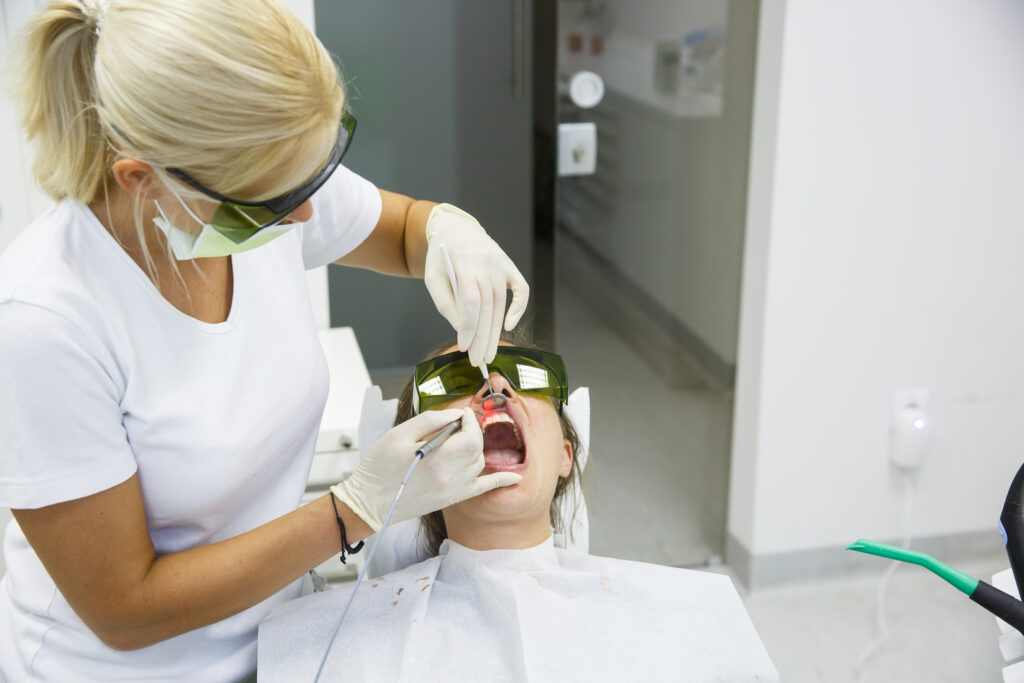
Laser dentistry has been used around the world for decades to detect and treat many dental problems. Lasers create light energy in a narrow, focused beam. When the laser light contacts dental or gingival tissue, it creates a chemical reaction that removes or shapes hard and soft tissues.
How can lasers enhance dentistry?
Dentists use laser technology for many reasons, including:
- Waterlase™ technology to remove both hard and soft tissues without a traditional drill.
- DIAGNOdent™ pens that detect cavities without the need for x-rays, scratching probes, or exploratory excavations.
- LaserSmile™ to dramatically whiten teeth on average nine shades lighter in less than an hour.
- Treating gum disease
- Reduce and even out the gumlines
Advantages
The goal of most dentists is to give their patients effective and comfortable treatments. Laser dentistry offers exceptional advantages over traditional approaches:
Help Diminish Dental Anxiety
According to the American Dental Association, one out of five adults avoids the dentist because of fear. Loud sounds (like drills) can trigger irrational thoughts and fears, which may cause patients to feel more tense or insecure.
Lasers do not generate vibrations, noise, and frictions like conventional dental tools, so they are often better for patients who deal with apprehension towards the dentist’s office. Instead, dental lasers make a soft, methodical pulsing sound which usually soothes patients.
More Comfortable
Instead of applying sharp metal tools in the mouth, laser dentists use high-energy light to pinpoint decay or excess tissue. Many laser treatments are virtually unproblematic and do not typically require anesthesia. In a study published in the Journal of Dentistry comparing laser and conventional cavity therapy, over 80% of patients prefer laser treatment and deem it more comfortable.
More Precision and Less Invasion
Lasers are extremely precise. Compared to conventional dental treatments, there’s a lower risk of:
- Bacterial infection
- Bleeding
- Swelling
Contemporary lasers sterilize and cauterize as they go. In most cases, patients do not require stitches. All of these benefits contribute to shorter recovery periods for laser dentistry treatments in comparison to traditional therapies.
Enhance Fillings
If a cavity needs to be filled, Waterlase™ technology can help increase bond strength due to the “no-smear layer” cavity preparations.
Disadvantages
Laser dentistry is not a suitable treatment for every dental case. While relatively low, there are some limitations and risks associated with laser dentistry.
Limitations
Laser dentistry may not be appropriate for all cases, such as:
- Fillings: Lasers cannot be used on teeth with metal amalgam fillings present.
- Outdated restorations: Lasers cannot remove old, damaged restorations (such as crowns and bridges).
- Interdental, excessive tooth decay: Lasers cannot fill cavities that are large or between teeth.
Tissue Damage
If used at the wrong wavelength or power level, lasers could damage oral and ocular tissues:
- Tooth pulp: Hard lasers can sometimes damage the center of the tooth (composed of blood vessels and connective tissue).
- Eye tissue damage: Lasers are powerful. To avoid eye damage, dentists supply special goggles to protect the eyes. Please wear them as instructed.
Consult with a Professional
Dr. Helen Ragsdale helps patients in Austin weigh advantages and disadvantages before receiving any laser dental treatment. If you have additional questions or concerns regarding laser dentistry, contact us by calling 512-346-4690 or message us online to schedule an appointment at Austin Laser Dentist today.
